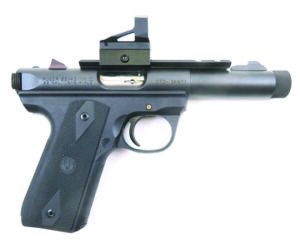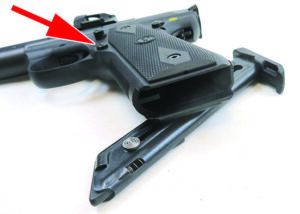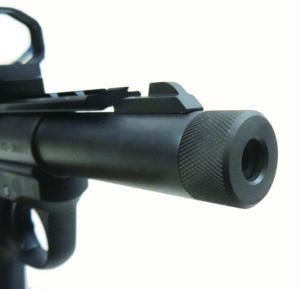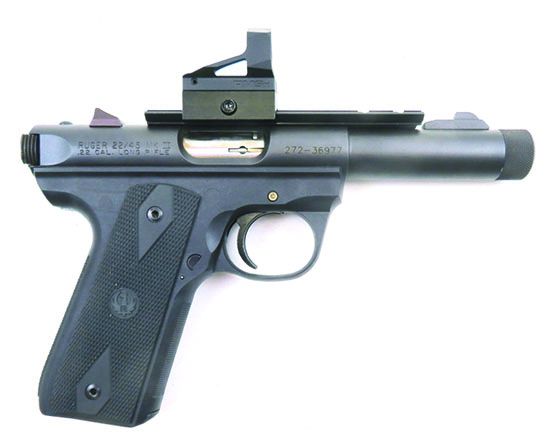Interested in shooting 22 Long Rifle pistols with red dots either at paper targets or steel plates? Ringing steel with smallbore pistols is fun. Some might say addictive. But gearing up for smallbore-pistol target shooting can be confusing because there are many choices between pistols and red-dot optics. Also, putting a ton of money into a 22 LR target pistol might not be in the budget for most shooters, but if you want to play, you’ll still want to invest enough into the pistol and optic to be competitive on the common courses of fire.
For example, one basic set up is to shoot at five to seven steel targets no smaller than 8 inches in size. Five strings are shot, and the four lowest-scored strings are your total score. Even this simple course of fire puts a premium on the gun/optic combo, with the gun needing to be accurate, reliable, and easy to move between targets, and the optic presenting a clear, simple dot that is easy to read and follow target to target.
Accordingly, we wanted to match up suitable pistols with reliable red dots. The pistol budget was set at $450 and the optic budget at $300. The goal was to have a pistol set up for about $800, not including tax and transfer fees. Happily, we came in under budget for all the pistol and optics combos. Going cheap on the red-dot optic is possible because there are many available well under $300. So we went with brands we know and have used in the past. The same was true of 22 LR target pistols. We found a Taurus TX22 Competition for $419, pairing it with a Crimson Trace RAD Micro Pro, $219, with a green dot. Total cost was $718. Middle of the pack was a KelTec CP33 ($469) and an Ultradot 6 ($289) for a total of $758. On the high end was a like-new-in-box used Ruger MK III 22/45 Threaded Barrel for $450, paired with a Shield Sight RMSx, $489, at $789.
How We Tested
Red dots allow the user to shoot with both eyes open for a wide field of view and no tunnel vision aiming. So, for the “action” style of shooting reactive targets, these optics are ideal.
What has not been ideal have been the means of putting optics on handguns, but this process is getting better. Gun manufacturers have made mounting a red dot simple by including mounting plates that are compatible with the footprint of popular optics. For instance, the Crimson Trace RAD Micro Pro has the same footprint as the Shield RMS or JPoint reflex sights. The Ultradot 6, however, mounts like a scope, using rings that clamp onto a Weaver or Picatinny rail. So, as part of our evaluation, we focused on the ease with which we could:
• Mount a red dot on the pistol
• Zero the sight
• Use the dot reticle
• Assess battery life and replacement, and
• Determine a sight’s ruggedness.
For the pistols themselves, we evaluated them on:
• Grip comfort
• Ease of and speed of loading and unloading
• Slide manipulation
• Magazine loading
• Trigger-pull weight
• Balance
• Ability to customize
• Accuracy, and
• Reliability.
Also, because they are target pistols chambered for 22 LR, we looked at field-stripping and cleaning them. Rimfire ammo with lead bullets and dry lube can quickly gunk up an action, so maintenance is important.
Ammo used consisted of two hot high-velocity loads and two mild target loads. On the hot side were CCI AR Tactical rounds with 40-grain copper-coated lead bullets and Federal AutoMatch with a 40-grain lead bullet. On the mild side were Remington Target rounds with 40-grain lead bullets and Eley Tenex with 40-grain lead bullets. All of the ammunition is specifically designed for target shooting and made for use in semi-auto pistols and rifles. Despite them all using 40-grain bullets, results varied by gun.
After we zeroed the sights, we set targets at 20 yards and employed a rest to gauge bench accuracy. For speed shooting and reload manipulations, we used paper plates as targets and set up the course at 10 yards. We then fired Bill Drills — six fast shots inside a small A zone — to see how well the pistols could be fired, controlled, and reloaded.
At the outset, we wondered if we paid too much for the used Ruger/Shield Sight combo or if the mid-priced Taurus/Crimson Trace duo would make a good set up? Was there anything good about the least expensive KelTec/Ultradot set up? Here’s what we found:
Ruger Mark III 22/45 10150 22 LR
$300
Gun Tests grade: A-
The grip angle of the 22/45 makes it a natural pointer. The trigger was heavy but consistent. The Shield Sight offered a huge sight window, making dot acquisition fast.

| Action | Semi-auto |
| Overall Length | 8.5 in. |
| Overall Height | 5.3 in. |
| Maximum Width | 1.3 in. |
| Weight Unloaded | 32.0 oz. |
| Weight Loaded | 33.2 oz. |
| Barrel | 4.5 in. long, 1:16 RH twist ½-28 tpi muzzle threads |
| Slide | Blued steel |
| Slide Retraction Effort | 13.0 lbs. |
| Frame | Black Zytel polymer |
| Frame Front Strap Height | 2.5 in. |
| Frame Back Strap Height | 3.2 in. |
| Grips | Checkered polymer |
| Grip Thickness Maximum | 1.1 in. |
| Grip Circumference Maximum | 5.5 in. |
| Front Sight | Fixed blade |
| Rear Sight | Fixed groove |
| Sight Radius | 6.3 in. |
| Trigger Pull Weight | 4.8 lbs. |
| Trigger Span | 2.5 in. |
| Magazines | (2) 10 round, steel with polymer base pad |
| Safety | Manual thumb |
| Warranty | None written |
| Telephone | (336) 949-5200 |
| Website | Ruger.com |
| Made In | U.S. |
Since the introduction of the new MK IV 22/45 pistols, there are plenty of used MK III 22/45 guns for sale, and our test gun here was a gently used MK III 22/45 Threaded Barrel model. The 22/45 pistols used the same barrel receiver as the standard MK III pistols. The difference is the frame. The 22/45 uses a polymer frame with the same grip angle as a 1911. Standard MK III pistols have a more angled grip, like the iconic Luger P-08. The frame uses 1911-style grip panels so you can swap the grips with any grip made for a full-size Government 1911. The front grip strap and rear back strap are checkered offering sure grip.
Our test gun came with two steel-tube magazines with polymer base plates and a soft case. All the controls are buttons that are the same size and shape, which can make it confusing for a shooter unfamiliar with the 22/45. The magazine-release button is located in the same position as a 1911 so it can be operated with thumb of the shooting hand for a right-handed shooter. The slide release is at the top edge and forward of the grip, normal location for a slide stop, and is pressed down to release the bolt. The safety is located on the left side in the typical thumb-safety position and can be flicked on and off with your thumb, if you shoot right handed. On the left side of the barrel receiver is a loaded chamber indicator, which protrudes when a case or live round is in the chamber.
The trigger is curved and serrated and broke at 4.8 pounds, though it didn’t feel that heavy. We would have liked that closer to 3 pounds. We know many shooters who opt for 22/45 pistols and then install a Volquartsen Completion Kit ($187 at Volquartsen.com) or they polish the trigger parts to reduce the pull weight. We left the factory trigger as is for this review. To cock the pistol, pull back on the two ears of the bolt, which requires 13 pounds of effort.

The muzzle is threaded for a compensator or a brake. Sights are fixed, and the barrel receiver is also drilled and tapped. A Weaver base ($23 at ShopRuger.com) was attached to the barrel.
The Shield Sight RMSx (Reflex Mini-Sight XL Lens) features an 80-percent-larger window than other reflex sights from Shield Sight. This model was designed specifically for competition shooting and offers a wide field of view through the screen. This sight was very easy to see through and acquire the red dot much faster. It is made of aluminum and features a very thin base, so the sight can be mounted closer to the center of the bore. It runs on a CR2032 battery for about three years, and is always on. You need to remove the sight to replace the battery, so remember to re-zero the sight. The 4-MOA red-dot reticle is a good size for fast acquisition and no target obstruction. Dot brightness automatically adjusts to ambient light, and this worked in bright and dim light. A groove in the rear of the base allows the sight to co-witness with iron sights on some pistols. A mount was needed to attach the RMSx to the Weaver rail. An inexpensive optic adapter plate ($20 at Amazon.com) was used. The rail offered options for optic placement. It was mounted just aft of the trigger so the balance was above the grip.
There are no direction indicators on the Shield sight, but a mini dial is included in the box that slips over the hex wrench and provides windage and elevation direction. Remember to move the dot to point of impact when zeroing.

The magazine does not fall free, similar to most target pistols. The steel body has a button on the follower to compress the magazine spring so cartridges are easily dropped in. During accuracy testing, we encountered two FTF jams with the Remington Target load, but everything else hummed along fine. The pistol was lightweight, so there was a small amount of muzzle flip during recoil, which was easy to control. The 22/45 was the second most accurate pistol in the match up and nipped at the heels of the KelTec. The best group measured 0.62 inch with Remington Target ammo. Second best was the hotter Federal AutoMatch with a 0.70-inch group. The CCI and Eley were 1.37 and 1.31 inches, respectively. On average, the shot groups were from 0.76 inch to 1.55 inches. Like most 22 LR pistols, the Ruger made it known what ammo it preferred.
On the plates, the 22/45 was smooth operating. Because the bolt cycles inside the barrel receiver, it does not disrupt the sight picture. The trigger was predictable and repeatable. Like the other pistols, a compensator or brake will give the pistol a bit more weight to help flatten the recoil. The Shield sight was like a big-screen TV, offering a wide field view so you can get on the next target without having to find it.
The bolt locked back on last round fired. On a standard MK III pistol, just pull the bolt to the rear as far as it will go to chamber a round. On 22/45 models, the bolt stop must also be depressed to permit the bolt to fly forward or just press the bolt stop button.
Disassembling the Ruger MK III 22/45 is easy, but reassembling can be complicated, hence the reason the MK IV was introduced. Because the rail and optic mounted to the barrel receiver, there is no need to re-zero the optic. We found that 22/45 can run dirty, so field-stripping is not necessary after each shooting session.
Our Team Said: The trigger on the 22/45 felt lighter than it actually was, and that was a good thing since it didn’t seem to hinder accuracy. The Shield Sight is excellent for fast shooting. This would be the sight we’d choose for a target pistol because of the wide screen and field of view. The 22/45 is a nice base for a target pistol with plenty of aftermarket accessories.
| 22 LR RANGE DATA | |||
| CCI AR Tactical 40-grain Copper Coated Lead | KelTec CP33 | Ruger MK III 22/45 | Taurus TX22 Competition |
| Average Velocity | 1066 fps | 994 fps | 1040 fps |
| Muzzle Energy | 101 ft.-lbs. | 88 ft.-lbs. | 96 ft.-lbs. |
| Smallest Group | 0.68 in. | 1.37 in. | 0.97 in. |
| Average Group | 0.76 in. | 1.44 in. | 1.09 in. |
| Federal AutoMatch 40-grain Lead | KelTec CP33 | Ruger MK III 22/45 | Taurus TX22 Competition |
| Average Velocity | 1009 fps | 988 fps | 1009 fps |
| Muzzle Energy | 90 ft.-lbs. | 87 ft.-lbs. | 90 ft.-lbs. |
| Smallest Group | 0.65 in. | 0.70 in. | 0.82 in. |
| Average Group | 0.68 in. | 0.76 in. | 0.83 in. |
| Remington Target 40-grain Lead | KelTec CP33 | Ruger MK III 22/45 | Taurus TX22 Competition |
| Average Velocity | 932 fps | 957 fps | 980 fps |
| Muzzle Energy | 77 ft.-lbs. | 81 ft.-lbs. | 85 ft.-lbs. |
| Smallest Group | 0.61 in. | 0.62 in. | 1.39 in. |
| Average Group | 0.70 in. | 0.76 in. | 1.46 in. |
| Eley Tenex 40-grain Lead | KelTec CP33 | Ruger MK III 22/45 | Taurus TX22 Competition |
| Average Velocity | 934 fps | 877 fps | 915 fps |
| Muzzle Energy | 77 ft.-lbs. | 68 ft.-lbs. | 74 ft.-lbs. |
| Smallest Group | 0.52 in. | 1.31 in. | 1.02 in. |
| Average Group | 0.71 in. | 1.55 in. | 1.33 in. |
Written and photographed by Robert Sadowski, using evaluations from Gun Tests Team members. GT


























I got rid of my Ruger Mark IV. It didn’t matter what ammo we fed it it jammed and jammed more often than not.
We replaced it with the Taurus TX22. No more jamming and improved practice sessions.